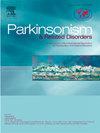无监督定义本质性震颤的两种临床亚型及其潜在的大脑拓扑。
IF 3.4
3区 医学
Q2 CLINICAL NEUROLOGY
引用次数: 0
摘要
背景:本质性震颤(ET)是最常见的神经系统疾病之一,其临床表现和预后差异很大,这表明存在亚型。识别 ET 亚型对于解释临床异质性至关重要。本研究旨在利用基于临床表现的无监督聚类分析确定 ET 亚型,并在功能和结构网络中探索潜在的大脑拓扑结构:方法:我们招募了 103 名 ET 患者和 43 名健康对照组受试者。方法:我们招募了103名ET患者和43名健康对照者,根据发病年龄、运动和非运动症状进行K均值聚类分析,以识别ET亚型。功能磁共振成像和弥散张量成像数据用于构建功能和结构网络。计算全局属性(聚类系数、特征路径长度、全局效率和局部效率)和节点属性(节点聚类系数、节点效率和节点度中心性),进行拓扑分析:我们发现了两个亚型:亚型 1(发病年龄较早--无非运动症状亚型)和亚型 2(发病年龄较晚--有非运动症状亚型)。与NC型相比,亚型2的聚类系数和全局效率降低,特征路径长度增加,而亚型1仅全局效率降低。在亚型 2 中特别观察到更广泛的脑区,其节点聚类系数降低:我们根据全面的临床信息确定了两种 ET 亚型,并发现亚型 2 可能是一种恶性程度更高的亚型。我们的研究首次无监督地识别了 ET 的临床异质性,并为更好地理解潜在的疾病生物学提供了神经影像学证据。本文章由计算机程序翻译,如有差异,请以英文原文为准。
Unsupervised definition of two clinical subtypes of Essential tremor and the underlying brain topology
Background
Essential tremor (ET) is one of the most prevalent neurological diseases varying considerably in clinical manifestations and prognosis, which indicates the existence of subtypes. Identifying ET subtypes is crucial for explaining clinical heterogeneity. This study aimed to identify ET subtypes using unsupervised clustering analysis based on clinical manifestations and explore underlying brain topology within both functional and structural networks.
Methods
We recruited 103 ET patients and 43 healthy control subjects. K-means clustering analysis was performed to identify ET subtypes based on age of onset, motor and non-motor symptoms. Functional MRI and diffusion tensor imaging data were used to construct functional and structural networks. Global attributes (clustering coefficient, characteristic path length, global efficiency, and local efficiency) and nodal attributes (nodal clustering coefficient, nodal efficiency, and nodal degree centrality) were calculated for topological analysis.
Results
We identified two subtypes: Subtype 1 (earlier age of onset – without nonmotor symptoms subtype) and Subtype 2 (later age of onset – with nonmotor symptoms subtype). Decreased clustering coefficient and global efficiency, increased characteristic path length were observed in Subtype 2 compared to NC, while only decreased global efficiency was observed in Subtype 1. More widespread brain regions with decreased nodal clustering coefficient were specifically observed in Subtype 2.
Conclusion
We identified two ET subtypes based on comprehensive clinical information and revealed that Subtype 2 may be a more malignant subtype. Our study firstly unsupervisedly identifies the clinical heterogeneity of ET and provides neuroimaging evidence for better understanding the underlying disease biology.
求助全文
通过发布文献求助,成功后即可免费获取论文全文。
去求助
来源期刊

Parkinsonism & related disorders
医学-临床神经学
CiteScore
6.20
自引率
4.90%
发文量
292
审稿时长
39 days
期刊介绍:
Parkinsonism & Related Disorders publishes the results of basic and clinical research contributing to the understanding, diagnosis and treatment of all neurodegenerative syndromes in which Parkinsonism, Essential Tremor or related movement disorders may be a feature. Regular features will include: Review Articles, Point of View articles, Full-length Articles, Short Communications, Case Reports and Letter to the Editor.
 求助内容:
求助内容: 应助结果提醒方式:
应助结果提醒方式:


